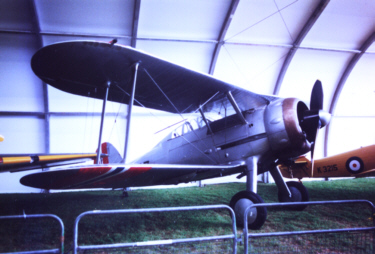
the Gloster Gladiator,the RAF's last biplane fighter,entering service in 1938
return to index
With the end of the first world war in November 1918,a great reduction in military spending was made.This made its self felt throughout the armed forces. The cutbacks strenghtened Farnboroughs position as the other,smaller,research were closed and everything was centered on Farnborough.
Great strides had been made in aviation during world war one.Aircraft had come from hardly being able to support their own weight to being able to carry a bomb, or passenger load hundreds of miles.
The 1920's saw a steady,if quiet time,time at Farnborough.The RAF was only a shadow of its former self, and the only action was in repressing warring tribes in the empire.Very little real progress was made in aviation.This was due to continueing financial restraints,and the result of the depression.
Helicopters made their first appearance in the 1920's.True manned rotary flight was 20 years away but successful experiments were made with large models.Also at the time the autogyro appeared.It got its lift by replacing a conventional aircraft's wings with rotors.The forward motion of the aircraft's normal engine powering the rotors.
A great deal of work was also done on pilot-less,remote control aircraft,these being launched from land and see to act as targets.The late 1920's and early 1930's saw the birth of RADAR,much of which was pioneered at Farnborough.In terms of the site there was steady growth.The first large scale wind tunnels,big enough to fit a full scale aircraft, were opened.Along with structural test labs,and radio labs.The naval tests were also tansfered here in the 20's,resulting in the building of gradually more powerful catapults.
During the inter war years the RAF maintained some of its few home based squadrons at Farnborough.This was mostly the resident No4 squadron until the late 30's when it became the HQ of the Anti Aircraft co-operation unit.
With the end of the economic depression,and the rise of Hitler the workload of the RAE increased rapidly. The late 1930's saw a great impetus by the aircraft industry to produce modern types.The prototypes of many of the wars great aircraft came through Farnborough for evaluation and research.The likes of the Hurricane,Spitfire,Wellington,Lancaster, and the less successful ones.Foreign aircraft became increasingly common for evaluation as the UK kept a eye on the rest of the world.
By 1939 the airfield had grown considerably,all the available land was taken for the airfield.A new housing estate,Rafborough,was in full use,and the local flying area was very active
